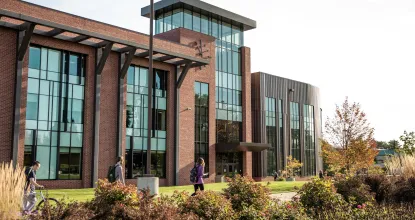Here are some examples operational savings due to sustainability actions.
Installing vending machine “misers”
NMU has installed VendingMisers on all of the cold drink vending machines on campus. VendingMiser uses a Passive Infrared Sensor (PIR) to power down the machine when the area surrounding it is vacant. Then it monitors the room’s temperature and automatically re-powers the cooling system at one to three hour intervals, independent of sales, to ensure that the product stays cold. By installing these devices, the estimated annual savings in electricity is approximately $7,000.
AdIT saves cooling costs
Administrative Information Technology (AdIT) has raised the temperature set point in its data / server rooms to reduce the cooling load, and has initiated the built-in power management function for all networking and server equipment to produce an estimated savings of $2,000 annually.
New campus lighting program
Plant Operations implemented a lighting program to save on energy costs by reducing exterior lighting when pedestrian activity is at its lowest level. Between 1-7 a.m. when school is in session and all night during the summer and winter break, lighting will be reduced in select areas. Minimum lighting levels still meet standards followed by most municipalities. This employee-suggested program is estimated to reduce energy cost by almost $9,000 annually; while still providing a pedestrian-safe environment.
New method for scheduling classes
In an effort to reduce energy costs and improve classroom utilization, the Registrar’s office (with a special thanks to Mike Truscott), faculty and Plant Operations have worked together to schedule weekend classes more efficiently; Saturday courses located in Jamrich Hall have been re-assigned to available classroom space in the Science Complex. With no Saturday classes, the heating, cooling, and lighting systems in Jamrich Hall can be turned down saving energy ~ approximately $7,000 per semester.
New boilers realize big savings
Lincoln Street Apartments gas usage in units (#24 – 45 & laundry) is down (-) 29% over last year due to the newer high efficiency boilers that were installed in fall. The boilers were installed by a local mechanical contractor (apartments) and NMU trades staff (laundry). The efficiency amounts to a cost avoidance, factoring in the decrease in gas costs, of approximately $3,887 for the month of November.
Preventative checking of steam traps
Steam traps are mechanical devices installed to remove water (condensed steam) from the steam flow ensuring proper operation of the steam distribution system used for heating, hot water, and air conditioning. A single failed trap on the mainline can be a loss of approximately $5,000/annually. Plant Operations staff conduct an annual audit of over 1,600 steam traps throughout campus to determine traps that have failed open or are leaking, which saves the university thousands of dollars in utility costs. The NMU steam trap failure rate is approximately 4.7% which is far below the national average of 15-20%.
Employee's Energy-Saving Idea Implemented
An NMU electrician’s idea to reduce exterior lighting levels on campus during low-traffic periods will save about $9,000 per year in energy costs. Tom Olson (Plant Operations) noticed that two parking lots serving the residence halls—lot 20 west of the Armory and 46 north of Wright Street—remained vacant over the summer, yet were fully illuminated each evening. He wondered if it might be possible to reduce their lighting levels from May through August to save money without compromising safety.
“There’s been a push across the university to look for ways to cut down on energy use and for individual departments to look for ways to cut other costs where they can,” Olson said. “This seemed like one direction we might look first instead of losing positions.”
Urged to expand the idea beyond the two parking lots and beyond the summer period, Olson and fellow electrician Jeff Kyllonen analyzed how lighting is controlled in the core of campus and suggested other areas where it could be reduced overnight. They later joined officials from both public safety and engineering and planning in a lighting survey.
“We came in one night, reduced the lighting, took a reading of the levels and tried to gauge how the change would affect pedestrian safety”, said Jim Thams (Engineering and Planning). “Of 508 light poles on campus, we found that 122 could be programmed to turn off at 1 a.m. and back on at 7 a.m., when activity is lowest, while still meeting NMU’s minimum standard and exceeding the Illuminating Engineering Society standard followed by most municipalities. We have to buy time clocks to control the fixtures, but we’ll see a payback on that investment in less than a year. We should be ready to roll this out in a couple of weeks once the time clocks arrive and are installed.”
The locations where lighting levels will be reduced from 1-7 a.m. are: the Jacobetti Complex, lot 17 near Whitman Hall, north campus, the academic mall and the Hedgcock area. This program does not include reductions in any residence hall parking lots. The two locations that sparked Olson's original idea, lots 20 and 46, will be impacted only during the summer. NMU public safety also maintains an escort service to assist those who feel uncomfortable walking on campus during hours of darkness.
“This project is a great example of NMU putting employee suggestions to work to reduce energy costs. Three departments worked together to develop an idea that will provide real savings with minimal investment. I would encourage any employee with energy savings suggestions to submit their idea to gogreen@nmu.edu," said Kathy Richards (Engineering and Planning/Facilities).
Light bulbs are associated with good ideas, particularly when they flash on above a character’s head in a cartoon or comic strip. But in Olson’s case, it was the vision of turning off the light bulb that blossomed into an energy- and cost-saving idea.
